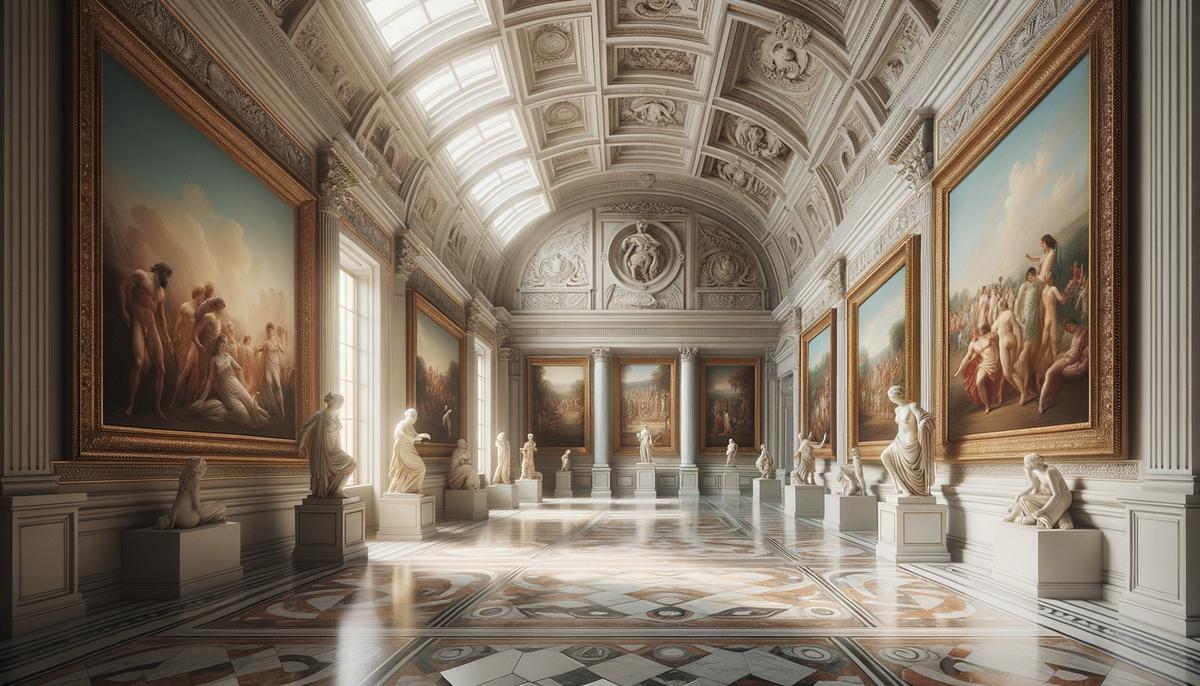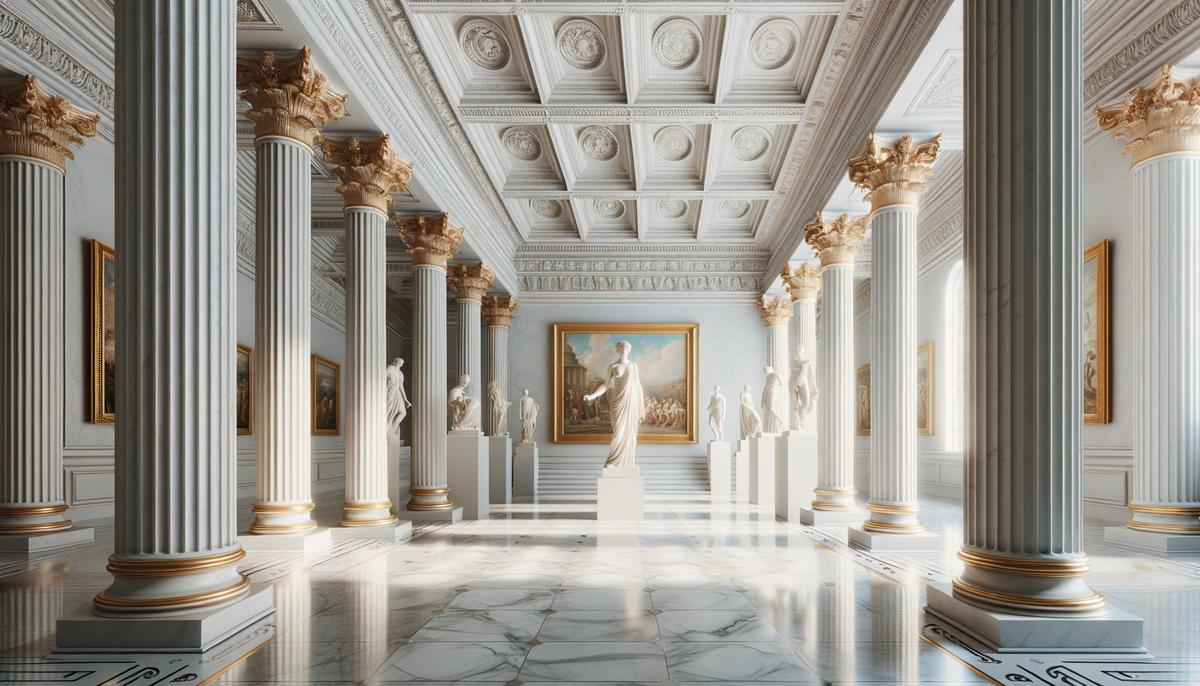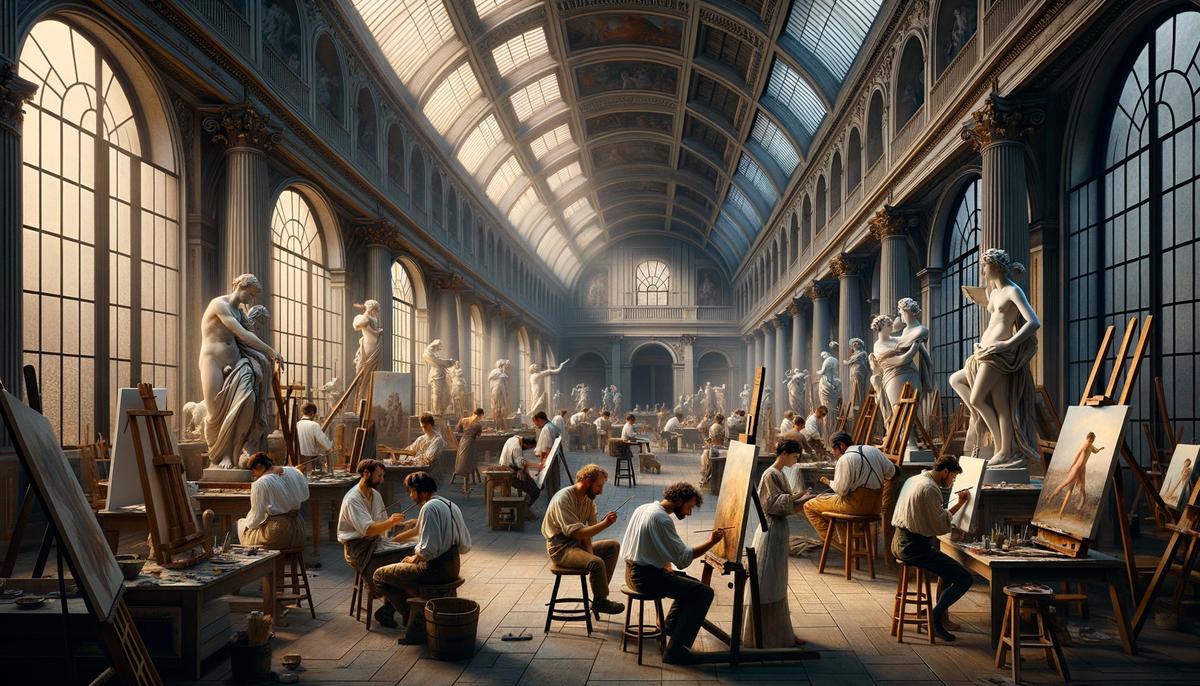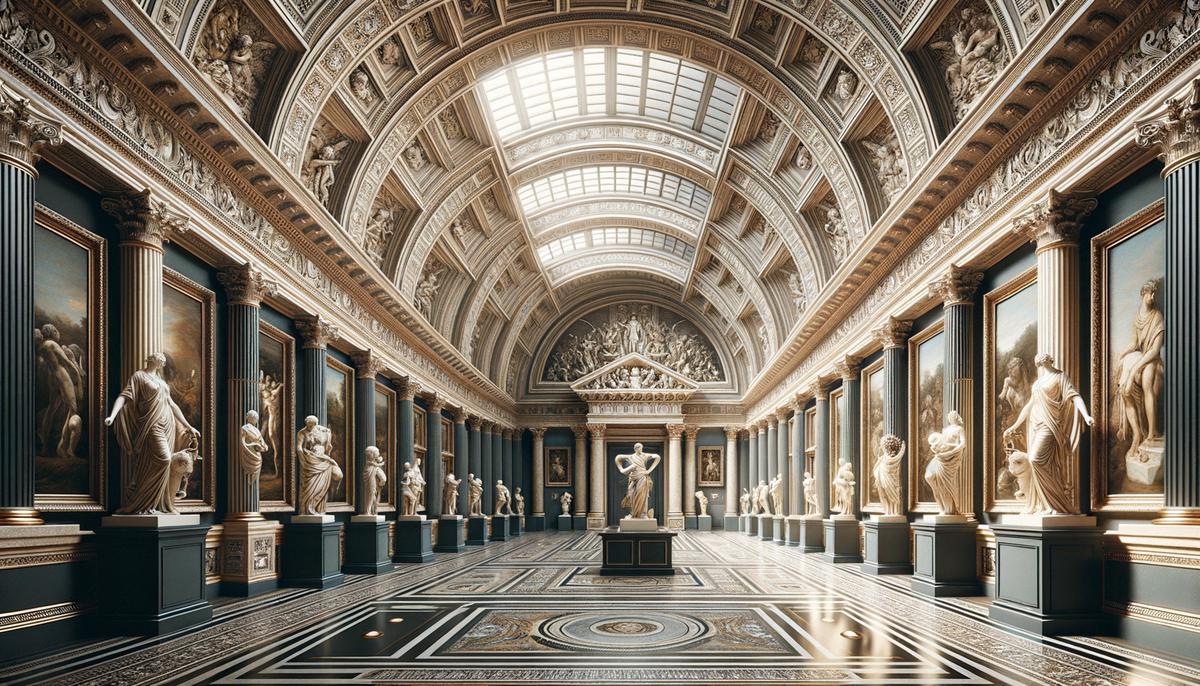Origins
Neoclassical art emerged as a refreshing alternative to the extravagance of Baroque and Rococo. Artists looked back to the simpler, more virtuous aesthetics of Greek and Roman cultures, favoring the orderly and harmonious over the intricate and embellished, signaling a return to classical ideals of beauty and proportion.
Johann Joachim Winckelmann, a renowned German art historian, championed this shift. His passionate essays evoked an appreciation for the ancient world, advocating for "noble simplicity and calm grandeur". Winckelmann's insights into ancient Greek and Roman art captured the imagination of artists, his ideas forming the foundation of Neoclassicism.1
The groundbreaking discoveries at Pompeii and Herculaneum provided a visual resource for those drawn to ancient cultures. These newly unearthed cities offered tangible connections to the past, a physical reference that artists could draw direct inspiration from, infusing their creations with historical accuracy and authenticity. These lost cities were no longer mere stories; they were real, with artworks, sculptures, and architecture that artists could experience firsthand.
The broader Age of Enlightenment also influenced these shifts. This era's emphasis on reason, science, and individual liberty seamlessly integrated into the ethos of Neoclassical art. It aimed for more than just beauty—it sought to reflect enlightened values through understated elegance, a balanced approach that shone through simplicity.
These currents combined, providing an alternative to the extravagance of Baroque and Rococo art. Through Winckelmann's philosophical perspective, the remarkable realities uncovered in Italian soils, and the enlightened spirit of the times, Neoclassicism emerged. It was an art movement that reflected a society yearning for a return to rationality, as seen in every brushstroke that aspired towards classical ideals.

Characteristics
Neoclassicism, born from the Enlightenment and classical archaeology, exhibited distinctive characteristics that unfolded across the canvases and architecture of the time. Let us explore these hallmarks, examining the path walked by artists who, guided by classical ideals, brought simplicity back into fashion.
Simplicity and Symmetry
Neoclassical art embraced simplicity, moving away from the elaborate style of Rococo. Artists cleansed their palettes of excess, opting for a minimalistic approach. Canvases and structures commanded attention through serene dignity. Symmetry became a key element of designs, providing visual balance and harmony.
Jacques-Louis David's Oath of the Horatii exemplifies this blend. Three figures, embodying Rome's virtues, pledge allegiance with symmetrical certainty, reflecting Neoclassicism's balanced essence.2
Moral Virtue
Neoclassical art emphasized morality as a necessary component. Paragons of ethical strength leaped from ancient texts onto canvas and marble, embracing virtuousness. Statues depicted not only ideal physical forms but also moral ideals to emulate, harkening back to a time when nobility, courage, and sacrifice were valued.
Classical Antiquity
Greek columns and Roman togas were more than stylistic choices; they were historical references crafted with newfound accuracy, thanks to the excavations at Pompeii and Herculaneum. Artists and architects became historians, their works echoing the essence of ancient civilizations with precision. Temples, theaters, and sculptures, once remnants of history, now served as inspiration for a generation keen on bridging past and present.
Neoclassical works often served as history lessons, adorned with stories from history or mythology. Artworks subtly encouraged viewers to engage with the intellectual fabric of ancient societies.
Frequently featuring scenes stripped of time-specific identifiers, Neoclassical art presents alternate universes where characters, forever clad in togas, grapple with timeless life dilemmas. It's where legendary figures from the past teach us about bravery in battle, wisdom in statecraft, and the craft of eloquence.
Through its emphasis on simplicity, symmetry, and moral virtue, infused with the authenticity of classical antiquity, Neoclassical art provided an alternative to the excesses of its precursors. It underscored a cultural maturity craving art that was not mere ornamentation but a repository of mankind's highest ideals – a cleaner, more orderly chapter in civilization's ongoing story. It exchanged Rococo frills for Greco-Roman austerity, doing so within an enlightened thought current, making every column and chiseled cheekbone a reference to the quest for simplicity, moral high ground, and a nostalgia informed by historical truth.

Key Figures
The Neoclassical period, immersed in the sober light of reason and wrapped in the aesthetics of ancient Rome, was an art movement where the key figures have since become staples in art schools and the dreams of aspiring painters. At the forefront of this renaissance of Classical principles stood artists who not only painted or sculpted but brought to life philosophical doctrines. Let us walk through the gallery of these notable masters whose palettes were as much dipped in the hues of moral virtue as in the pigments of their time.
Jacques Louis David
First on our list is Jacques Louis David, a name that commands respect in the art world. Often called the Standard-bearer of Neoclassicism, David's canvases were visual treatises on the Enlightenment, seamlessly woven with the thread of classical antiquity. His Oath of the Horatii is a call for civic duty, a masterclass in symmetry, and a powerful representation of Roman values.2
David's art revolved around the gravity of moral stoicism and patriotic sacrifice – scenes meticulously chosen from history or mythology. His storytelling, where each stroke revealed secrets of the past, transformed viewing into a dialogue with ancient spirits. Through pieces like The Death of Socrates, David not only captured history but sculpted the very soul of Neoclassicism, proving that paint, when wielded by a master, can stir the hearts of nations.
Antonio Canova
If David painted the dreams of stone, then Antonio Canova was the sculptor who coaxed marble into waking life. This giant among sculptors possessed an almost divine skill—breathing life into stone with such finesse that even the gods would admire his creations. Canova's works, from Psyche Revived by Cupid's Kiss to Perseus with the Head of Medusa, transcend mere sculpture; they are sensual representations in marble, epitomizing the movement's affinity for classical narratives and physical idealism.3
Angelica Kauffmann
Angelica Kauffmann graced the period with a touch both tender and powerful. As adept with the brush as she was poignant in her narratives, Kauffmann championed the neoclassical spirit through the delicate force of emotion and intellect. Her canvases, teeming with the exploits of heroines and gods, break from traditional confines, pulling at the heartstrings while demanding cerebral engagement. A founding member of the Royal Academy, amidst skepticism towards female artists, she painted not only portraits but also a bold testament to feminine influence in the arts.4
Jean-Auguste-Dominique Ingres
Ingres, a name that flows off the tongue as smoothly as his brushstrokes glide across canvas. Where David's figures stood embedded in stoic virtue, Ingres' characters seemed to breathe with a lyrical air, their curves echoing the undulating lines of ancient pottery. Whether The Grand Odalisque or Oedipus and the Sphinx, Ingres mastered the art of drawing not just bodies but souls curved by passion and draped in antiquity, making him a pillar of Neoclassicism; anchored yet fluid.
Together, these artists didn't merely illustrate a bygone era; they wielded their brushes and chisels like Hermes' staff, guiding the aesthetic and intellectual spirit of their age towards a classical rebirth. They were more than artists; they were visionaries at a cultural crossroads, echoing the ancient call for beauty, virtue, and reason but with a contemporary fervor that resurrected Athens in the salons of Paris. In their capable hands, Neoclassicism was not an anachronistic yearning but quite literally, art in its classic moment – resplendent and enlightened.

Impact
Neoclassical Art's Influence on Society and Time
Neoclassical Art as a Social Force
Examining the influence of Neoclassical art reveals its deep impact on society. Jacques Louis David and his fellow artists were more than painters and sculptors; they were social influencers, their art a tool shaping contemporary thought and politics. Neoclassical art, infused with Enlightenment principles, didn't just adorn gallery walls; it permeated intellectual circles, influenced the corridors of power, and spread to the streets, a visual representation of order, virtue, and revolution.
The art form was a subtle yet powerful vehicle for social change – David's The Death of Marat, igniting revolutionary sentiment, or Canova's Hebe, embodying the essence of neoclassical ideology. Through their noble simplicity and silent rebuttal of Rococo indulgence, these works became societal mirrors reflecting ideals worth striving for – seeds sown into the soil of consciousness, blooming through the ensuing centuries.
Artistic and Architectural Influence
Neoclassicism wasn't content merely to be the muse for poets or the inspiration for revolutionaries; it aimed to shape the world in its Grecian image. As society stood on the edge of industrial revolutions and democratic changes, architecture embraced the Neoclassical principles.
Neoclassicism etched its ideals across facades; from grand governmental edifices to civic buildings, each stood as a testament to harmony, symmetry, and democratic virtues. They embodied the intellectual strength of Western civilization, fashioning a physical narrative of Neoclassicism's socio-political commentary.
Relationship with Romanticism
The relationship with Romanticism was akin to a rivalry yet a symbiotic dance. While Neoclassicism celebrated order and rational beauty, Romanticism was the passionate counterpart to Neoclassical stoicism, enthralled by emotion, individuality, and nature's untamed wilderness.
Yet, this wasn't just art's version of a contest; both movements coalesced in a beautiful paradox. Artists sometimes explored both styles, painting Neoclassical calm before embracing Romantic fervor. This dynamic tension underscored an evolving dialogue on human expression, manifest destiny, and the essence of beauty, carving out future paths for Modernism and beyond.
Neoclassicism bid adieu but left behind a legacy that would influence the future; no matter how art evolved, it could trace its roots back to that engaging period of artistic awakening. Herein lies Neoclassical art's lasting impact: shaping society's ethos, inspiring architectural renaissance, and engaging with Romanticism only to jointly influence future art movements.
Neoclassicism was more than a genre; it was a vibrant epoch that refined the edges of society, clarified the lens through which we viewed our past, and charted a course towards aesthetic enlightenment. Every stroke and stone placed was not just art; it was history in the making—a step along the path towards modernity.

- Winckelmann JJ. Thoughts on the Imitation of Greek Works in Painting and Sculpture. Dresden: Walther; 1756.
- Crow TE. Painters and Public Life in Eighteenth-Century Paris. New Haven: Yale University Press; 1985.
- Honour H. Neo-classicism. Harmondsworth: Penguin; 1977.
- Roworth WW. Angelica Kauffman: A Continental Artist in Georgian England. London: Reaktion Books; 1992.





















